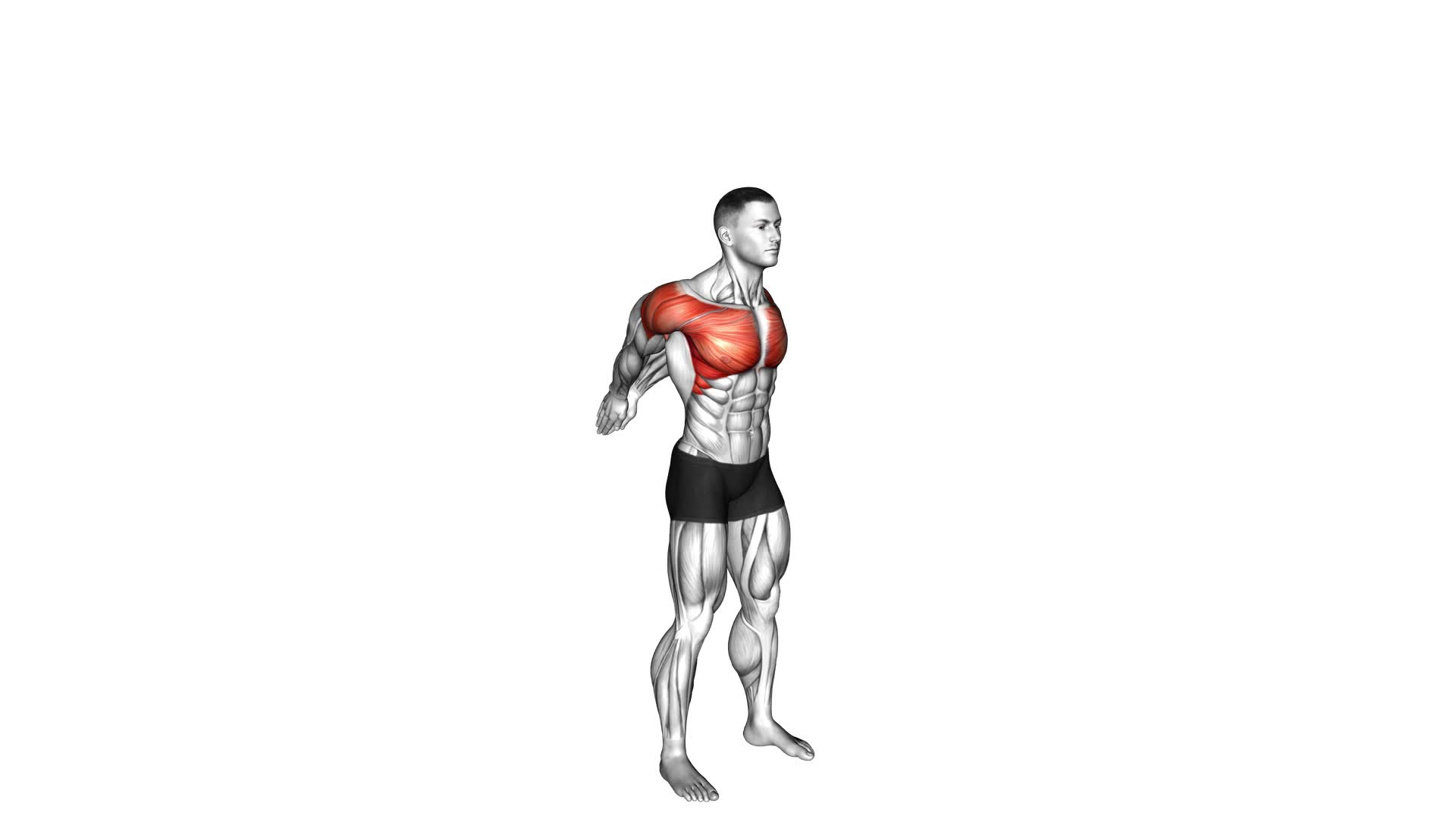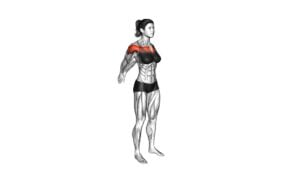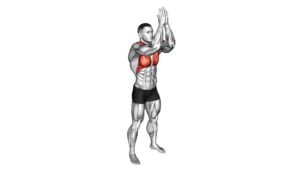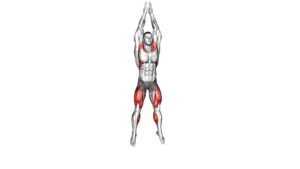Standing Top Clap Back Clap (male) – Video Exercise Guide & Tips

Are you looking for a challenging exercise to amp up your workout routine? Look no further than the Standing Top Clap Back Clap.
Watch This Exercise Video
This dynamic move targets your upper body, core, and coordination, giving you a total body workout.
In this video exercise guide, you'll learn the proper technique, variations, and common mistakes to avoid.
Whether you're a beginner or an experienced fitness enthusiast, this exercise will push you to new limits.
Let's get started!
Key Takeaways
- Standing Top Clap Back Clap is a beneficial exercise for increasing upper body strength and improving cardiovascular endurance.
- This exercise targets multiple muscle groups, including the chest, shoulders, and triceps, while engaging the core.
- Safety precautions such as warming up, focusing on proper breathing technique, and maintaining proper form and posture should be followed while performing this exercise.
- The exercise can be modified to make it easier or more challenging, depending on the individual's fitness level and goals.
Benefits of the Standing Top Clap Back Clap
Experience increased upper body strength and improved cardiovascular endurance by incorporating the Standing Top Clap Back Clap into your workout routine. This dynamic exercise targets multiple muscle groups, including the chest, shoulders, and triceps, while also engaging your core and promoting cardiovascular fitness.
The Standing Top Clap Back Clap is an effective way to build upper body strength. As you perform the exercise, the explosive movement of clapping your hands behind your back activates your chest and shoulder muscles, helping to develop strength and definition. Additionally, the quick and powerful motion engages your triceps, enhancing their overall strength and tone.
In addition to building muscle, the Standing Top Clap Back Clap also improves cardiovascular endurance. The fast-paced nature of the exercise elevates your heart rate, allowing for a more intense cardiovascular workout. This helps to improve your overall endurance and stamina, making it easier to perform other high-intensity exercises or activities.
While the Standing Top Clap Back Clap is a highly effective exercise, it may not be suitable for everyone. If you're looking for alternative exercises that provide similar benefits, push-ups and medicine ball slams are great options. These exercises also engage the upper body and promote strength and cardiovascular endurance.
Incorporating the Standing Top Clap Back Clap into your workout routine can lead to significant improvements in upper body strength and cardiovascular endurance. Consider adding this exercise to your fitness regimen and enjoy the benefits it has to offer.
Safety Precautions for Performing This Exercise
To ensure your safety while performing the Standing Top Clap Back Clap exercise, follow these important precautions:
- Warm up before performing the exercise: It's crucial to warm up your muscles and joints before engaging in any physical activity. This will help increase blood flow to the muscles, improve flexibility, and reduce the risk of injury.
- Focus on proper breathing: Proper breathing plays a significant role in performing this exercise correctly and safely. Remember to inhale deeply through your nose before starting the movement and exhale forcefully as you clap your hands behind your back. This will help stabilize your core and provide the necessary support for the exercise.
- Maintain proper form: Pay attention to your posture throughout the exercise. Keep your spine aligned, shoulders back, and engage your core muscles. Avoid arching or rounding your back, as this can strain your spine and increase the risk of injury.
- Start with lighter weights: If you're using dumbbells or any other weighted object for this exercise, start with lighter weights and gradually increase the resistance as your strength and technique improve. This will help prevent overexertion and minimize the risk of muscle strains or joint injuries.
- Listen to your body: If you experience any pain or discomfort during the exercise, stop immediately and consult a fitness professional or healthcare provider. It's essential to listen to your body's signals and avoid pushing yourself beyond your limits to prevent injuries.
Proper Technique and Form for the Standing Top Clap Back Clap
To perform the Standing Top Clap Back Clap exercise with proper technique and form, focus on maintaining a strong core and engaging your upper body muscles.
Start by standing with your feet shoulder-width apart and your knees slightly bent. Keep your back straight and your shoulders relaxed.
When it comes to hand positioning, place your hands behind your head with your fingers interlocked. This will help to stabilize your upper body and engage your core muscles.
As you begin the exercise, hinge forward at the hips while keeping your back straight. Lower your upper body and bring your chest towards the ground.
Next, explosively push yourself back up, driving through your heels and engaging your core. As you reach the top of the movement, clap your hands together above your head.
To maintain proper form throughout the exercise, make sure to keep your core engaged and your back straight. Avoid rounding your shoulders or arching your back.
Variations and Modifications to Make the Exercise Easier or More Challenging
Now let's explore the different ways you can modify the Standing Top Clap Back Clap exercise to make it easier or more challenging.
There are progressive difficulty levels that allow you to gradually increase the intensity as you improve.
If you're a beginner, there are also adaptations available to help you build strength and confidence.
On the other hand, if you're an expert looking for a greater challenge, there are advanced modifications that can push your limits and take your workout to the next level.
Progressive Difficulty Levels
Adjustments can be made to the exercise to either increase or decrease the difficulty level. Here are some modifications and progressions you can try:
- Beginner Modifications:
- Start by performing the exercise with a lighter weight or no weight at all.
- Reduce the number of repetitions or sets.
- Decrease the range of motion by not fully extending your arms or legs.
- Advanced Progressions:
- Increase the weight you're using for the exercise.
- Add an extra set or increase the number of repetitions.
- Incorporate a stability challenge by performing the exercise on an unstable surface, such as a Bosu ball.
Remember to listen to your body and choose modifications or progressions that suit your current fitness level. It's important to gradually increase the difficulty over time to avoid injury and keep making progress.
Adaptations for Beginners
If you're a beginner, you can make adaptations to the Standing Top Clap Back Clap exercise to either make it easier or more challenging.
To make it easier, you can start by performing the exercise without any weights. This will help you focus on mastering the form and technique before adding additional resistance. Another modification is to decrease the range of motion by not bringing your hands all the way down to your sides, but instead stopping them at shoulder height. This will reduce the difficulty and allow you to build strength gradually.
On the other hand, if you want to make the exercise more challenging, you can increase the weight you're using or add a resistance band for added resistance. This will engage your muscles even more and increase the intensity of the exercise.
Remember to listen to your body and choose the adaptation that suits your fitness level.
Advanced Modifications for Experts
Looking to take your Standing Top Clap Back Clap (male) exercise to the next level? Here are some advanced modifications for experts that will challenge your muscles and elevate your workout:
- Increase the speed of your claps to intensify the exercise.
- Add ankle weights or resistance bands to increase resistance and strengthen your muscles.
- Perform the exercise on an unstable surface, such as a Bosu ball or balance board, to engage your core and improve stability.
- Incorporate a jump into the clap to add plyometric power and enhance cardiovascular endurance.
- Try performing the exercise on one leg to challenge your balance and target specific muscle groups.
By incorporating these expert modifications, you can make the Standing Top Clap Back Clap exercise even more challenging and push yourself to new limits.
Now, let's move on to the next section and learn about common mistakes to avoid when doing the standing top clap back clap.
Common Mistakes to Avoid When Doing the Standing Top Clap Back Clap
To avoid common mistakes when doing the Standing Top Clap Back Clap, it's important to focus on proper hand positioning, timing, and coordination.
Make sure your hands are aligned with your shoulders and wrists are straight to prevent strain.
Additionally, timing and coordination are crucial to ensure a smooth and effective execution of the exercise.
Lastly, engage your core throughout the movement to maintain stability and prevent any unnecessary strain on your back.
Proper Hand Positioning
Place your hands shoulder-width apart on the ground, with your fingers pointing forward, to ensure proper hand positioning for the Standing Top Clap Back Clap exercise. Proper hand positioning is crucial to maximize the effectiveness of this exercise and prevent injuries.
Here are some common mistakes to avoid when it comes to hand grip and wrist alignment:
- Avoid gripping the ground too tightly, as it can strain your wrists and limit your range of motion.
- Keep your fingers spread wide to distribute your weight evenly and provide stability.
- Make sure your wrists are aligned with your forearms to maintain a neutral position and reduce the risk of injury.
- Avoid bending your wrists excessively, as it can put unnecessary strain on the joints.
- Keep your palms flat on the ground to provide a solid base of support and engage your core muscles.
Timing and Coordination
When it comes to timing and coordination in the Standing Top Clap Back Clap exercise, it's essential to maintain proper hand positioning as discussed in the previous subtopic. However, hand-eye coordination and rhythmic movements are equally important factors to consider.
To achieve optimal results, focus on synchronizing your hand movements with the rhythm of the exercise. Make sure your hands move in a smooth and controlled manner, avoiding any jerky or abrupt motions. This will help you maintain balance and stability throughout the exercise.
Additionally, keep your eyes focused on your hands to ensure accurate timing. By practicing hand-eye coordination and mastering rhythmic movements, you can improve your overall performance and get the most out of the Standing Top Clap Back Clap exercise.
Core Engagement Technique
Maintain proper core engagement throughout the Standing Top Clap Back Clap exercise to optimize your results and avoid common mistakes. Core activation is crucial for stability and power during this movement. Here are some key tips to ensure you're effectively engaging your core:
- Keep your abdominal muscles tight throughout the entire exercise.
- Imagine pulling your belly button towards your spine to activate your deep core muscles.
- Avoid arching your back or letting your lower back sag.
- Engage your glutes to support your core and maintain a strong posture.
- Breathe deeply and exhale forcefully as you perform the clap motion to engage your core even further.
By practicing proper core engagement techniques, you can maximize the benefits of this exercise and enhance your core strength training.
Tips for Incorporating This Exercise Into Your Workout Routine
To incorporate this exercise into your workout routine, you can start by adding it to your upper body strength training sessions. The Standing Top Clap Back Clap is a dynamic exercise that targets your upper body muscles, primarily your chest, shoulders, and triceps. It also engages your core muscles for stability and balance.
To begin, stand with your feet shoulder-width apart and your knees slightly bent. Hold a dumbbell in each hand at shoulder height, with your palms facing forward. From this starting position, press the dumbbells overhead, fully extending your arms. As you bring the dumbbells back down, simultaneously clap your hands behind your back and then in front of your body.
Incorporating this exercise into your routine won't only help you build upper body strength but also improve your coordination and agility. You can perform it as a standalone exercise or as part of a circuit training routine. For example, you can alternate between sets of Standing Top Clap Back Clap and cardio exercises like jumping jacks or mountain climbers.
Remember to start with light weights and gradually increase the resistance as you become more comfortable with the movement. Aim for 2-3 sets of 10-12 repetitions, with a rest period of 30-60 seconds between sets. Always listen to your body and adjust the intensity and duration of your workouts accordingly.
Frequently Asked Questions
How Many Calories Does the Standing Top Clap Back Clap Exercise Burn?
To maximize calorie burn during the standing top clap back clap exercise, it's important to focus on proper form and technique. Engage your core, keep your back straight, and use controlled movements.
By maintaining a steady pace and fully extending your arms, you can increase the intensity and calorie burn of the exercise.
Remember to stay hydrated and listen to your body for any signs of fatigue or discomfort.
Can the Standing Top Clap Back Clap Exercise Help Improve Upper Body Strength?
The standing top clap back clap exercise is a great way to improve your upper body strength. By incorporating variations of this exercise into your workout routine, you can target different muscles in your arms, shoulders, and back.
Upper body exercises like the standing top clap back clap can help increase muscle mass, improve posture, and enhance overall strength and stability. Adding this exercise to your fitness regimen can provide numerous benefits for your upper body.
How Long Should I Hold Each Clap Position During the Exercise?
When performing the standing top clap back clap exercise, it's important to focus on the quality of each movement rather than the duration. Instead of worrying about how long to hold each clap position, concentrate on maintaining proper form and engaging your upper body muscles.
For beginners, you can modify the exercise by starting with smaller claps and gradually increasing the range of motion as you build strength.
Incorporating the standing top clap back clap exercise in a full body workout can help improve upper body strength and enhance overall muscle coordination.
Are There Any Alternatives to the Standing Top Clap Back Clap Exercise for Those With Shoulder Injuries?
If you have shoulder injuries, there are shoulder-friendly alternatives and modifications for the Standing Top Clap Back Clap exercise. Some options include modified push-ups, resistance band exercises, or seated dumbbell exercises that focus on the upper body without putting excessive strain on the shoulders. These alternatives can help you continue strengthening your upper body while protecting your shoulder joints.
It's important to remember that I'm discussing alternatives to this exercise specifically.
Can the Standing Top Clap Back Clap Exercise Be Included in a Cardio Workout Routine?
Yes, the standing top clap back clap exercise can be included in a cardio workout routine. It offers cardio benefits by engaging multiple muscle groups and increasing heart rate.
For beginners, modifications can be made by performing the exercise at a slower pace or reducing the range of motion. Remember to listen to your body and start with lighter weights before progressing.
This exercise is a great addition to your cardio routine for a full-body workout.
Conclusion
Incorporating the Standing Top Clap Back Clap into your workout routine can offer a range of benefits, such as strengthening your upper body and improving coordination.
However, it's crucial to prioritize safety and maintain proper technique while performing this exercise.
By following the outlined variations and modifications, you can tailor the exercise to meet your fitness level.
Remember to avoid common mistakes and always consult a professional if you're unsure about any aspect of this exercise.

Author
Years ago, the spark of my life’s passion ignited in my mind the moment I stepped into the local gym for the first time. The inaugural bead of perspiration, the initial endeavor, the very first surge of endorphins, and a sense of pride that washed over me post-workout marked the beginning of my deep-seated interest in strength sports, fitness, and sports nutrition. This very curiosity blossomed rapidly into a profound fascination, propelling me to earn a Master’s degree in Physical Education from the Academy of Physical Education in Krakow, followed by a Sports Manager diploma from the Jagiellonian University. My journey of growth led me to gain more specialized qualifications, such as being a certified personal trainer with a focus on sports dietetics, a lifeguard, and an instructor for wellness and corrective gymnastics. Theoretical knowledge paired seamlessly with practical experience, reinforcing my belief that the transformation of individuals under my guidance was also a reflection of my personal growth. This belief holds true even today. Each day, I strive to push the boundaries and explore new realms. These realms gently elevate me to greater heights. The unique combination of passion for my field and the continuous quest for growth fuels my drive to break new ground.







